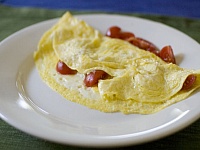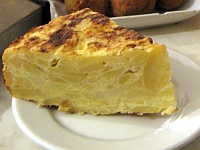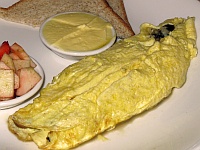 |
Serious Omelettes |
The Spanish tortilla de patatas or "Spanish omelette" is a typical dish in Spain, consisting of a thick cake made with eggs and potatoes sautéed in cooking oil. There are infinite variantions, with almost every Spanish home having its own. Some of the additions to the base ingredients are green peppers, chorizo, eggplant, mushrooms and ham. The texture and width of the tortilla varies according to regions and taste. Tortilla is almost always accompanied by bread and frequently by pickles such as olives and gherkins.
Frittata is an Italian open-faced omelette that can contain cheese, vegetables, or even leftover pasta. Frittate are cooked slowly. Except for the cooking oil, all ingredients are fully mixed with the eggs before cooking starts. Many vegetables can be added to the frittata such as onion, spinach, asparagus, potato, tomato, swiss cheese or mushrooms, but nothing compares with the exceptional taste of artichokes.
It should be noted that neither tortilla de patatas nor frittata are eaten for breakfast. In Spain tortilla de patatas is eaten as part of an evening meal. In Italy, a typical breakfast consists of a sweet croissant and a cup of cappuccino.
Omelette eaten in France is thin. It is smoothly and briskly cooked in a very hot pan, using a great deal of clarified butter. Clarified butted ensures a high smoke point and the omelette can be cooked on high heat. When made correctly, a French omelette will have little or no color on to it. Using a lot of butter prevents sticking and cooks the eggs more quickly, and also gives the omelette a nice buttery taste. A French omelette is typically seasoned with just salt and pepper and finely chopped herbs (tarragon, chervil, rosemary and thyme). French omelettes can be rolled out on the plate in a trifold design.
Denver omelette is a folded omelette usually filled with diced ham, onions and bell peppers. It is a rustic breakfast dish from the American West, sometimes also called Southwest omelette or Western omelette. Denver Omelette can be served with a topping of cheese and a side of hashbrowns or fried potatoes. A topping of spicy Mexican tomato salsa would make it, in the United States, a Spanish omelette. Obviously, the name "Spanish Omelette", as used in America, needs to be distinguished from the Spanish tortilla de patatas.

 |
Tortilla de patatas (Spanish omelette) |
Ingredients:
- 800g (1 3/4 lb) potatoes
- 30ml (2 tbsp) butter
- 15ml (1 tbsp) olive oil
- 1 onion, chopped
- 6 eggs
- Salt
- Parsley for garnish
Preparation:
- Preheat broiler.
- Peel the potatoes and cut them 1/2 inch slices. Boil them in salted water for about 5 minutes or until just tender. Drain and set aside.
- Melt 1 tbsp butter in a large sauté pan. Add the olive oil and onions, and stir vigorously to coat the onion thoroughly. Fry the onion gently for about 10 minutes or until it is soft, golden and sweet.
- Break the six eggs into a bowl, add a pinch of salt and beat them.
- Add the remaining butter to the onion mixture and as soon as it has melted add the potato. Stir well to get a good balance between the onion and potato.
- Add the beaten eggs to the frying pan. Cover the pan and let it cook through, 5-10 minutes.
- Place the pan under the broiler for 5 minutes or until browned.
- Slice into wedges and serve.
- YIELD: Serves 4 to 6

 |
Frittata con i Carciofi (Omelette with Artichokes) from Anna Maria Volpi |
Ingredients:
- 2 artichokes
- 1 lemon
- 4 tbsp extra-virgin olive oil
- 4 eggs
- Salt and pepper
Preparation:
- Drain the artichokes and cut them in very thin slices.
- Pour 2 tbsp olive oil in a non-stick skillet on medium heat. Add the artichokes, salt lightly and sauté until they become are soft.
- Lightly beat the eggs in a bowl, until fully combined. Add salt and pepper. When the artichokes are ready, pour the eggs in the skillet.
- When the egg starts to solidify, using a fork lightly scramble the center to let all the egg penetrate on the bottom. Shake lightly the pan back and forth to loosen the frittata and use a fork to loosen it from the edges of the pan. Lift the frittata to check that the bottom is cooked and golden.
- Make sure the egg on the top is not too running, then place on the pan a dish slightly larger than the pan. Rotate the pan and the dish together so that now the frittata is upside down on the dish.
- Add 2 tbsp of olive oil to the skillet then slide the frittata back into the pan so that the uncooked face is now on the pan.
- Lift the frittata to check that the bottom is golden. Slide the frittata on a serving dish and serve warm.
- YIELD: Serves 4 to 6

 |
Omelette Aux Fines Herbes (Classic French Omelette) |
Ingredients:
- 3 eggs, as fresh as possible, preferably organic and free-range, room temperature
- 2 tbsp clarified butter
- 1 tsp finely, freshly grated Parmesan or Gruy�re
- 2-3 fresh tarragon leaves, chopped
- 1 tbsp each of snipped chives, chopped chervil and parsley
Preparation:
- Warm an 8-inch non-stick frying pan on medium heat. Crack the eggs into a bowl and beat them with a fork so they break up and mix, but not as completely as you would for scrambled egg.
- With the heat on medium-hot, drop one tbsp of butter into the pan. It should bubble and sizzle, but not brown. Season the eggs with the parmesan and a little salt and pepper, and pour into the pan.
- Let the eggs bubble slightly for a couple of seconds, then take a wooden fork or spatula and gently draw the mixture in from the sides of the pan a few times, so it gathers in folds in the center. Leave for a few seconds, then stir again to lightly combine uncooked egg with cooked. Leave briefly again, and when partly cooked, stir a bit faster, stopping while there's some barely cooked egg left. With the pan flat on the heat, shake it back and forth a few times to settle the mixture. It should slide easily in the pan and look soft and moist on top. A quick burst of heat will brown the underside.
- Grip the handle underneath. Tilt the pan down away from you and let the omelette fall to the edge. Fold the side nearest to you over by a third with your fork, and keep it rolling over, so the omelette tips onto a plate - or fold it in half. For a neat finish, cover the omelette with a piece of kitchen paper and plump it up a bit with your fingers. Rub the other tbsp of butter over to glaze. Serve with a warm crusty baguette.
- YIELD: Serves 2.

 |
Denver Omelette (Western Omelette) |
Ingredients:
- 2 tbsp butter
- 1 medium sweet onion, finely chopped
- 1 red bell pepper, seeded and chopped
- 1 cup honey ham, chopped
- 8 eggs
- 1/4 cup milk
- 1 cup (4 ounces) cheddar cheese, grated
- Salt and freshly ground black pepper
Preparation:
- Heat the oven to 400 deg F.
- Grease a round 10-inch baking dish (or make the entire recipe in a cast-iron skillet).
- Melt the butter in a skillet over medium-low heat. Add the onion and bell pepper and cook for about 5 minutes, stirring occasionally, until soft. Add the ham and cook for 2 minutes more. Remove from heat.
- Beat the eggs and milk in a large bowl. Stir in the cheese and add the sauteed vegetables and ham. Season to taste with salt and pepper. Transfer the mixture to the prepared dish.
- If baking in a cast-iron skillet, pour egg mixture with cheese over the vegetables and ham. Bake for 20 minutes or until the top is puffy and brown. Cut into wedges. Serve warm.
- YIELD: Serves 4 to 6.
back to Radim and Lisa's Well-Travelled Cookbook | email us
Last updated: October 12, 2010
Some photographs from Wikimedia Commons
used under the terms of the GNU Free Documentation License.